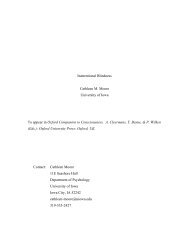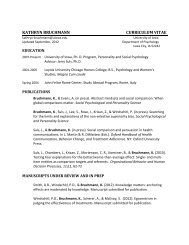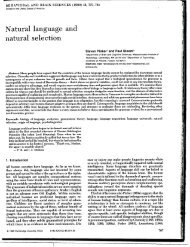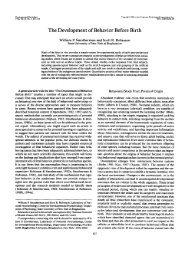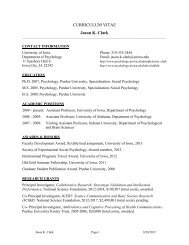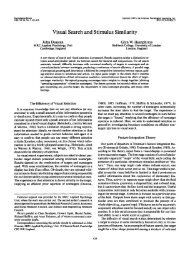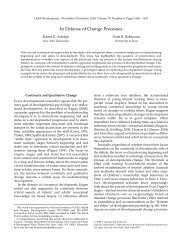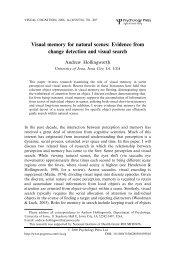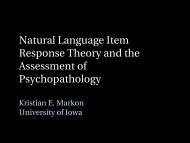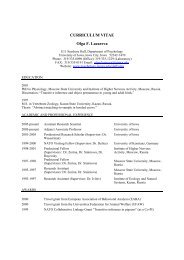Speech and language development following ... - ResearchGate
Speech and language development following ... - ResearchGate
Speech and language development following ... - ResearchGate
- No tags were found...
Create successful ePaper yourself
Turn your PDF publications into a flip-book with our unique Google optimized e-Paper software.
C. Ouellet, H. Cohen / Journal of Neurolinguistics 12 (1999) 271±288 277system <strong>and</strong> <strong>language</strong> acquisition <strong>development</strong> [34] <strong>and</strong> the negative correlationbetween age at onset of deafness <strong>and</strong> the <strong>development</strong> of speech perception,speech production <strong>and</strong> <strong>language</strong> competence <strong>following</strong> an implantation, it is clearthat younger children can derive signi®cant bene®ts from an implant [44]. Despiteobjections concerning biosafety problems such as head <strong>and</strong> temporal bone growth,otitis media, device extrusion or migration <strong>and</strong> the diculty of estimating theresidual hearing, or any other h<strong>and</strong>icap, of young patients [34], clinical experience<strong>and</strong> laboratory data strongly suggest that cochlear implantation is possible beforethe age of two [25]. Implantation may also result in better speech perception <strong>and</strong>overall linguistic performance in children as young as 16 months [58], probablybecause it reduces the <strong>language</strong> <strong>development</strong> delay.Although there are no age restrictions in terms of onset of deafness, the issue ofan upper age limit for this surgical operation is often debated. It has been arguedthat the decision to implant should be based solely on whether the patient's healthallows such a surgical intervention [44]. It has been shown that there are nosigni®cant di€erences in performance on closed-set tests of speech perceptionability between prelingually deafened children implanted before or after the age of®ve Ð even though the former performed better on open-set word recognition[19]. However, prelingually deaf children implanted after 12 years of age, whohave practiced <strong>and</strong> established a manual communication system, may show alower response <strong>following</strong> implantation. Although the procedure should not bedenied, Tyler et al. [84] do not recommend it for such patients.The criteria for implantation c<strong>and</strong>idacy have relaxed since the establishment ofthe ®rst national clinical trial of single-channel cochlear implants in 1979 [5].Initially, only deaf patients with bilateral profound sensorineural hearing loss whowere not able to perform open-set listening were considered for such an operation.Until 1991, no patients performing over 20% correct with conventionalampli®cation on open-set tests were implanted [91]. Recently, the US Food <strong>and</strong>Drug Administration approved the c<strong>and</strong>idacy of hearing-impaired adults withbinaural open-set sentence recognition scores no greater than 30% correct for theNucleus device [11]. According to Yaremko <strong>and</strong> Gibson [91], good hearing aidusers obtaining correct scores of between 30% <strong>and</strong> 50% on open-set tests shouldnot be automatically rejected. However, patients must be aware that any residualhearing in the implanted ear will likely be destroyed by the electrode insertion,thus precluding future use of a hearing aid in that ear.Patient selection is ®nally determined through audiological, medical <strong>and</strong>psychological assessments. During the audiological evaluation, the unaided <strong>and</strong>aided thresholds using conventional ampli®cation are established [44], giving ameasure of the functional hearing aid bene®t <strong>and</strong> allowing one to choose the earto be implanted - which is often the most a€ected one. The medical examinationincludes the otological history, the physical examination <strong>and</strong> the radiologicalevaluation of the cochlea. The etiology of the deafness may be determined in thisway. An otologically stable condition must be present to consider the feasibility ofthis surgical operation, which means an intact tympanic membrane <strong>and</strong> theabsence of infection or otitis media. Medical or surgical treatment prior to the



